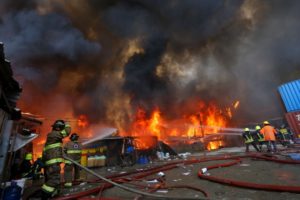
(CDN PHOTO/JUNJIE MENDOZA)
(First of two parts)
Members of the Hernandez family are unable to sleep at night every time it rains; as flood water seeps into a makeshift tent that is now considered their home.
The tent is located close to their burnt house in Sitio Beltran, Barangay Quiot, Cebu City.
Danilo, 61, Anecita, 53, and their four daughters aged 27, 25, 23 and 19 are among at least 300 people left homeless when a 26-minute fire ravaged
sitios Beltran and Upper Yati in the late afternoon of February 19.
“Pait kaayo kay maulanan mi unya ang among gipuy-an tent lang. Maapawan og tubig (Life has been very difficult for us because we only live in a tent and it would get flooded),” Danilo said.
On sunny days, his family also had to endure the scorching heat, Danilo added.
Danilo appeals to Cebu City Mayor Tomas Osmeña to allow them to already rebuild their houses so that life could return to normal.
“Nahatagan na mi ug mga hinabang, mga relief goods, pero wala pa ang financial. Unta mahatagan na mi og financial support para makapalit og kahoy para makatukod og payag (We we’re already given relief goods and other help but nothing financial. We hope they will give us financial support so that we can build even a hut),” Danilo said.
It was the first time for the Hernandez family to experience fire in the place where they had lived in for 28 years.
Cebu City fire investigators have yet to determine the cause of the blaze.
The Hernandezes lived right next to a house occupied by Carlito Dayanan where the fire reportedly started.
Fire-prone areas
In thickly populated areas like Cebu City, with a population of at least 922,611 residents based on a 2015 census, fire incidents are common.
Cebu City fires reported in 2017 resulted to the loss of P7.2 million worth of properties; while those in 2016 destroyed P15 million worth of properties.
Compared to other places in Central Visayas, Cebu City also topped the number of fires recorded with 236 incidences in 2016 and 248 in 2017.
During the first two months of 2018, the city again had the most number of fires in Central Visayas, totaling 32 incidents, with 17 recorded in January and 15 incidents in February. At least three persons were reported injured.
Major incidences, which transpired in January, included the huge fire in Metro Ayala at the Cebu Business Park last January 5 and another that hit sitios Lawis, Maharlika and Riverside, Barangay Pasil in January 14 which displaced an estimated 400 families.
An investigation conducted by the Bureau of Fire Protection (BFP) showed that the Pasil fire was a result of unsupervised children playing with matches.
Meanwhile, the Ayala mall fire remains under investigation.
On February 1, the blaze in Sitio Ilang-Ilang, Barangay Sawang Calero, which displaced at least 600 families, was the biggest fire recorded that month.
The incident, which remains under investigation, resulted to the loss of P2 million worth of properties.
Cebu City Fire Marshall Chief Insp. Noel Nelson Ababon said that most, if not all of the city’s urban barangays are considered fire-prone because of their huge population, the lack of access roads, and the presence of illegally parked vehicles.
“Kung asa tong mga concentrated barangays mao pud tong mga gagmay og access roads (Where there are concentrated barangays, that’s also where the access roads are small),” he told Cebu Daily News.
Ababon said that in some areas, like Sitio Tabok Canal, Barangay Pardo, the lack of an access road poses a big problem to the fire department.
In Barangay Pasil, access roads are also used for overnight parking making the place a fire hazard, he lamented.
Common causes of fire
Data from the Cebu City Fire Department showed that electrical short circuit was the most common cause of the city’s fires followed by accidents caused by open flame and lighted candles or kerosene lamps.
Ababon said electrical misuse was often the cause of electrical short circuits.
“Common man gud sa atoa nga mga Pinoy nga og natauran na ta og kuryente ang atong himoon mo palit dayon og mga gamit. Wala ta mag lantaw sa load sa kuryente. Wala nato tan-awa ang kaya sa load sa balay sa naandan. Kung magpataud ta og kuryente, ang ginataud minimum requirement lang nga load (It’s common among Filipinos that once we have an electrical connection, we immediately buy gadgets without first checking the load capacity. If we get a connection, most of the time, only the minimum load requirement is served),“ he said.
Ababon explained that power connections have to be regularly checked by an electrician as often as possible to determine if they remained safe for the household’s electrical load.
Ababon also warned against the use of octopus connections or an extension cord with multiple outlets and substandard wires.
Quennie Sanchez-Bronce, reputation enhancement manager of the Visayan Electric Company (Veco), meanwhile advised that electrical wiring installations of buildings and houses that are more than 10 years old should be inspected and tested at least once a year.
Wiring installations affected by calamities like earthquake, flood, or fire, must also be inspected, tested and repaired, if necessary; along with wire installations that have remained unused for at least a year.
For the month of January 2018 alone, the Bureau of Fire Protection in Central Visayas (BFP-7) recorded a total of 76 fires in Central Visayas which resulted to property damage amounting to P809.39 million.
At least two persons were reported to have died; while three others were injured.
While most of the fire incidents recorded by BFP-7 were found to be accidental, these were mostly caused by electrical misuse.
(To be concluded)

